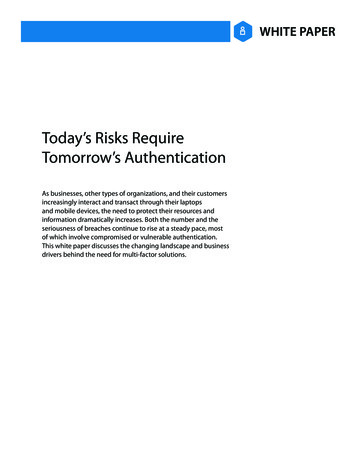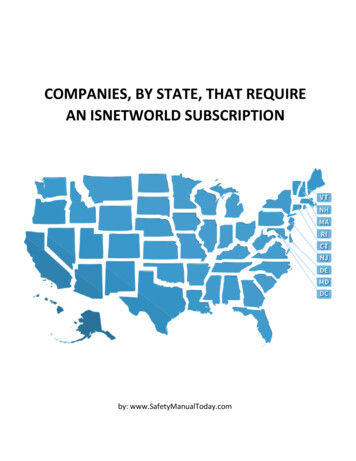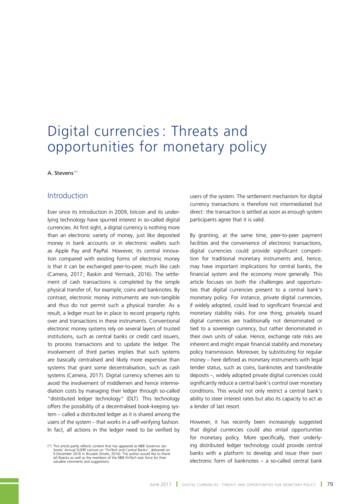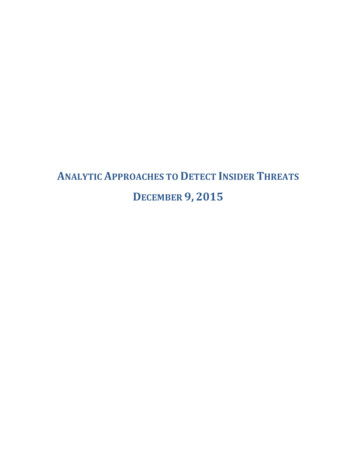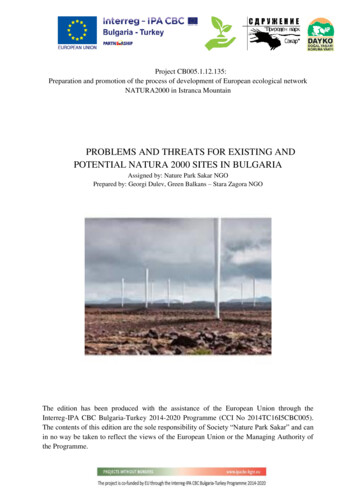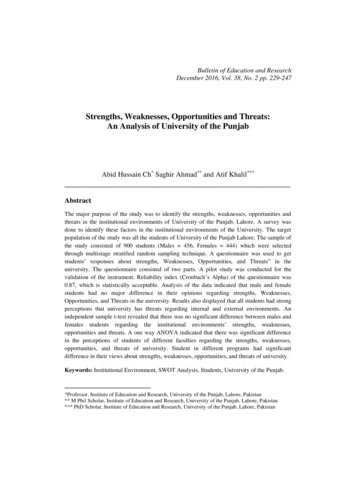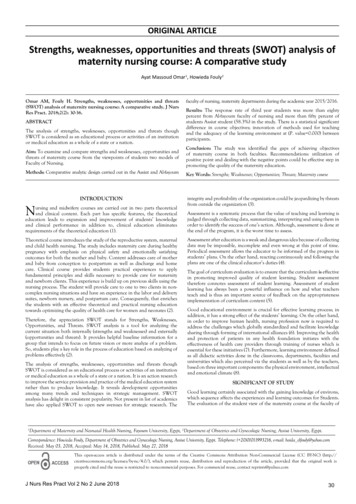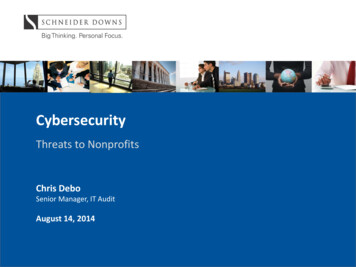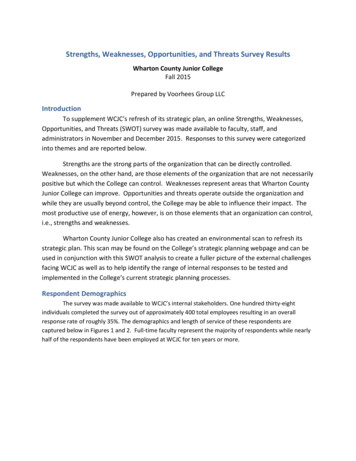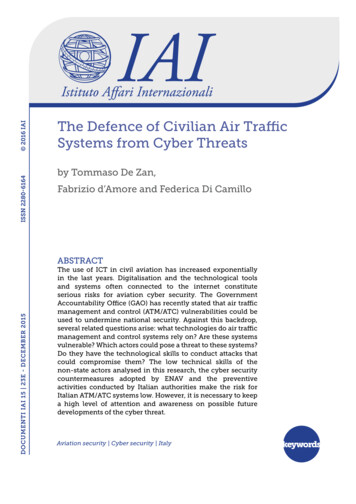
Transcription
WHITE PAPERTHINK APP SECURITY FIRSTADVANCED APPLICATION THREATSREQUIRE AN ADVANCED WAF
WHITE PAPER Advanced Application Threats Require an Advanced WAFThe threat landscape is dramatically different than it was just 5 years ago.A traditional web application firewall (WAF) was once a very effectivesolution for mitigating application layer attacks, but now has trouble keepingup with the advanced capabilities and agility of attackers. Signaturesoften lag behind new exploits. Even when a traditional WAF is capableof mitigating the threat, implementing and managing it properly can be achallenge. Today, new methods are needed to effectively automate themitigation of fast-evolving threats.Why are traditional WAFs inadequate?Traditional WAFs were created to address the problem of web application servers running codethat was vulnerable to a myriad of known attacks, especially cross-site scripting (XSS) and SQLinjection. WAFs have been deployed over the years to address these common vulnerabilities,but not without issues of false positives and operational complexity. The original open sourceWAF, ModSecurity, is often the target of bypass attacks or evasion techniques that attempt todefeat the largely passive, filter-based mechanisms it uses to detect malicious requestsNext-gen firewalls (NGFW) claim “application-aware” features and can also stop someinjection attacks (XSS, SQLi, and so on). But, NGFW still relies on passive filter detection anddoesn’t examine every HTTP request. Instead, it works much like an IPS, sampling requestsand examining their first few bytes, not the full request payload. As a result, application layerbypass attacks against NGFW technologies are common. Plus, IP address reputation feedsimplemented on NGFW and other firewall technologies have proven ineffective against botnetsand other automated threats.WAF technology has improved over the years, but it’s still largely based on those passive, filterbased methods used to detect malicious payloads and check for protocol compliance in webrequests. In addition, the operational complexity of managing WAF policies has caused manyorganizations to leave some applications unprotected. In many high-profile breaches, a knownapplication vulnerability was exploited because the targeted organization couldn’t patch theapplication server or deploy WAF policy quickly enough.Compounding these challenges, advances in automation technologies and the easy availabilityof botnets-for-hire have made detecting threats much harder. Automation technologies likeheadless browsers make it difficult to differentiate a human user from a bot, even with the useof CAPTCHA challenges. Botnets are built on the inexhaustible supply of easily compromisedIoT devices, cable modems, and browsers, rendering the source IP address almost useless fordetection and mitigation of botnet attacks.2
WHITE PAPER Advanced Application Threats Require an Advanced WAFAttackerMaliciousBotDMZ3Dedicated BotApplianceServerAgentTraditional WAFor NGFWCustomerFriendlyBotFigure 1: Automated threats bypass Traditional WAF and NGFW.Automated threats drive today’s attacks.DMZThe sourceof mostMaliciousattacks,regardless of type, is automated. DDoS attacks, data breaches,AttackerBotvulnerability scans, credential stuffing, brute force, resource hoarding, and other attack typesare almost all automated. Attackers use automation to launch large-scale attacks and probe forvulnerabilities despite often having less financial and human capital than the organizations theyAdvancedtarget. In many cases, these automatedF5attacksWAF contain no malicious payload and are crafted toCustomerbypass defenses by mimicking legitimate user traffic.Application layer (or layer 7) DDoS attacks have become a more common attack vectorFriendlybecause they can targetBot a resource-intensive URL with legitimate requests and simplyoverwhelm the application infrastructure. Similarly, credential stuffing (the automated use ofcompromised usernames and passwords) and brute force attacks designed to bypass loginauthentication are crafted by the attacker as legitimate requests. These login attacks areoften “low and slow” to avoid detection as a DoS attack.Malicious automated traffic and bots make up 30-40 percent of traffic on a typical site, but asmuch as 90 percent or more of the traffic to a targeted asset within that same site. The targetmight be a login page, as in brute force or credential stuffing, or a heavy URL, as in a layer 7DoS attack. In a resource hoarding attack, the attacker might target the purchase pages fordesirable tickets, sneakers, or other items. Scraping attacks similarly target data that’ll bemined for later use. These targeted attacks aren’t just difficult to detect, they also consumea disproportionate amount of infrastructure resources.The tools used to automate these attacks include headless browsers (for example Phantom.jsand Selenium), vulnerability scanners (the same ones used by penetration testers), commandline scripts, browser extensions, and even malware-infected machines.The weakest link? The browser.Browsers are often the weakest link in application security. Attackers try to compromise theuser via common phishing attacks embedded in email messages or social media posts. Clickingon malicious links enables attackers to embed malware on the target machine. That malwarecan be used to enlist the infected machine in a botnet army, to execute one of the attackstalked about in the last section.
WHITE PAPER Advanced Application Threats Require an Advanced WAFMore commonly, the malware takes the form of a Remote Access Trojan (RAT), keylogger, orsome other method of data gathering. These methods let the attacker harvest sensitive datasuch as username and password credentials, contact lists, and other information with potentialvalue on the black market. Protecting the user from credential theft is an especially dauntingtask when a browser or mobile app is the client. These client types offer limited options forenforcing the security posture of the endpoint device.DMZUsers often don’t knowthat their device hasbeen compromisedand stillDedicatedBot think the InternetMaliciousApplianceservice isAttackerprotecting Bottheir sensitive data. While HTTPS encryption providesServerdata protection inAgenttransit, it doesn’t protect the data when it’s entered at the endpoint.Traditional WAFPutting better application security controlsin place.or NGFWCustomerThe WAF has to evolve into an active security control, capable of interrogating the clientendpoint and strengthening the security posture of the application dynamically. The goodFriendlynews is, F5 AdvancedWAF employs countermeasures to detect and stop evolving applicationBotlayer threats. At a high level, Advanced WAF integrates behavioral analysis and dynamiccode injections as its two main mechanisms available to more completely assess the threatassociated with any given client session.AttackerMaliciousBotDMZF5 AdvancedWAFCustomerFriendlyBotFigure 2: Advanced WAF detects bots without server agents or dedicated appliances.By profiling a baseline of normal application traffic behavior, anomalous traffic patterns becomeeasier to spot. Just as automation has increased attacker’s capabilities, these technologies candifferentiate normal from anomalous traffic in ways a human security engineer never could. F5Advanced WAF uses advanced analytics and machine learning to generate dynamic signatureswhich block malicious traffic—without administrator intervention.Using JavaScript injections to assess whether a client is a browser with a human user,Advanced WAF establishes a client fingerprint and enables easier detection of bots and otherautomated tools. With client fingerprints, the attacker can also be tracked beyond an IP address.The proactive bot defense of Advanced WAF challenges each client session, detecting thenature of the client as well as differentiating friendly bots from malicious ones. The challengesare transparent to the user, reducing or eliminating the impact to the user experience (UX)associated with CAPTCHA challenges.4
WHITE PAPER Advanced Application Threats Require an Advanced WAF5Code can also be injected to encrypt user keystrokes dynamically, protecting a user from theirown malware-infected device. F5’s DataSafe1 technology implements this protection for usernameand password fields, preventing credential theft. This protection is vital because the target of 86percent of data breaches is identity or the application, based on research by F5 Labs2.Because the API can be notoriously difficult to secure against automated attacks, mobile APIshave increasingly become a target. With only the functionality of the mobile app instead of abrowser, mobile app developers are challenged to implement more robust security controls.The new F5 Anti-Bot Mobile SDK3 enables organizations to quickly integrate advanced securitycapabilities into their existing mobile apps with just a few mouse clicks.Here’s what you gain by focusing on automated threats.By shifting the focus to automated threats and employing more active securitycountermeasures, organizations can realize significant benefits over traditional WAFapproaches, including:Operational improvements All web applications share browsers and mobile apps as their clients, so it becomes easierto deploy a general WAF policy for most (ideally all) web applications. The web app withouta WAF policy or active patching becomes a thing of the past.Reduced risk Eliminating automated scanning from the attacker arsenal increases the effort it takesfor them to find the latest vulnerability in the application infrastructure. The risk that anunpatched server will be exploited on 0-day is dramatically reduced.Better use of resources With a traffic reduction of up to 40 percent, operating costs of the application servers aretrimmed, particularly in public cloud environments. Application server performance may alsoimprove under reduced load, resulting in an improved user experience. Reducing the baselineload also means web applications are less susceptible to application-layer DDoS attacks.The methods outlined here are a blueprint for thinking about web application security in a newway. It represents how F5 sees the threat landscape evolving. By using a more active approachto security via the use of tools like Advanced WAF, security professionals can put in place moreeffective controls and secure more applications. F5 is pioneering the Advanced WAF space byincluding comprehensive bot mitigation for web and mobile apps, credential protection in thebrowser, and automated behavioral analytics using machine learning.1 https://www.f5.com/pdf/products/application-level field encryption for credential and data protection.pdf2 a-breaches3 https://www.f5.com/pdf/products/integrate F5 anti-bot mobile SDK with any mobile app.pdf 2018 F5 Networks, Inc. All rights reserved. F5, F5 Networks, and the F5 logo are trademarks of F5 Networks, Inc. in the U.S. and in certain other countries. Other F5 trademarks are identified at f5.com. Any other products,services, or company names referenced herein may be trademarks of their respective owners with no endorsement or affiliation, express or implied, claimed by F5.DC0418 WP-SEC-222132511
The original open source WAF, ModSecurity, is often the target of bypass attacks or evasion techniques that attempt to defeat the largely passive, filter-based mechanisms it uses to detect malicious requests Next-gen firewalls (NGFW)
